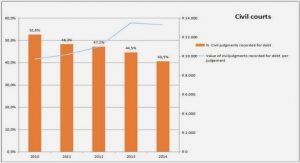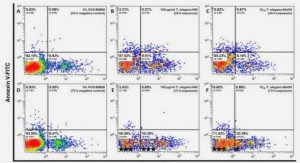Get Complete Project Material File(s) Now! »
Delay Detonators
In many explosive applications, such as mining, quarrying and other blasting operations, it is advantageous if the detonators are fired in a predetermined order rather than being fired simultaneously. This sequential timing and initiation of the explosive charges controls the fragmentation and throw of the rock being blasted. This approach also reduces ground vibration and air blast noise (Beck and Flanagan, 1992) and ultimately leads to greater effectiveness of the blast (Ellern, 1968). This effect is achieved by the use of delay detonators which provide a specified delay between actuation of the charge and the final detonation of the main charge. There are two main classifications of detonators, i.e. electronic and pyrotechnic. Electronic detonators achieve the desired time delay by use of wiring circuits or a programmed microchip with a timing circuit which is placed within the detonator. Electronic devices are generally more precise and more accurate than chemical pyrotechnic delays but they are considerably more expensive (Rugunanan, 1992; Beck and Flanagan, 1992; Ricco et al., 2004). Pyrotechnic detonators, on the other hand, use a pyrotechnic composition packed into a column to provide a time delay. This packed column is known as a delay element. Pyrotechnic detonators are generally simpler, more rugged, cheaper and do not require a power source. They also feature a higher degree of inherent safety compared with electronic elements (Kosanke et al., 2004; Danali et al., 2010).
Delay detonators consist of a metallic shell which is closed at one end and contains the following sequence of material starting from the delivery end: a base charge of a detonating high explosive such as pentaerithritol tetranitrate (PETN), followed by a primer charge of heatsensitive detonable material such as lead azide or lead styphnate, and then the delay element. The time taken for the composition in the element to burn from one end to the other provides the desired time delay (Davitt and Yuill, 1983; Beck and Flanagan, 1992). The delay composition in the detonator can be ignited by one of the following mechanisms: impact, an electrically heated bridge wire, or by the heat and flame of a low-energy detonating cord or shock tube (Davitt and Yuill, 1983; Beck and Flanagan, 1992). More recently, lasers have been used as a source of ignition in some applications (Trunov et al., 2005). Figure 2-1 shows the typical detonator construction.
Ignition and Propagation of Pyrotechnic Compositions
Kosanke et al. (2004) provided a detailed review of the ignition and propagation of pyrotechnic delay elements. They described ignition as the process of stimulating a pyrotechnic composition to release its internal energy. Pickard (2002) defines the ignition temperature as the minimum temperature to which a pyrotechnic composition must be heated in order to induce thermal runaway. To accomplish ignition, external energy has to be supplied. This energy increases the internal energy of the composition until it overcomes the minimum energy barrier (activation energy) and causes the release of the stored chemical energy in the composition (heat of reaction). It should be noted that although the ignition source increases the internal energy, the overall system also experiences thermal loss. In order for effective ignition to occur, the rate of heat generation within the material should exceed the rate at which heat is lost by radiation, convection and conduction to the surroundings. The rate of heat loss depends on the thermal diffusivity of the composition, the degree of packing, the convective heat loss coefficient, the geometry of the detonator and the difference in temperature between the composition and ambient temperature (Kosanke et al., 2004). Frank-Kamenetzky (1931), quoted by Merzhanov and Averson (1971), described the conditions necessary for ignition and propagation to occur; these were summarised using the graph shown in Figure 2-2. The diagram shows the relationship between heat generation and heat loss curves and the point where they intersect. At these intersection points the rate of heat generation is equal to the rate of heat loss. Point A corresponds to the low-temperature oxidation of the fuel, while point C represents the equilibrium combustion temperature. At point B the system is unstable and at temperatures slightly lower than TB, the rate of heat loss exceeds the rate of heat generation, resulting in the cooling of the material to TA. At temperatures slightly higher than TB, the exothermic heat generated will exceed the heat loss and the temperature of the composition will increase spontaneously to the steady-state flame temperature TC. Therefore, TB defines the lowest temperature at which the composition must be heated for it to ignite spontaneously (Merzhanov and Averson, 1971; Kalombo, 2005).
Silicon-Bismuth (III) Oxide (Si-Bi2O3) System
Boberg et al. (1997) patented the use of Si-Bi2O3 in slow (3–15 mm s-1) to fast (20–200 mm s1) delay compositions, depending on the stoichiometry of the composition, as well as the type and amount of additives used. Both Si and Bi2O3 are chemically stable, non-toxic reagents and their reaction takes place with minimal gas evolution, forming stable residue products. Kalombo (2005) and Kalombo et al. (2007) also reported on the Si-Bi2O3 delay composition using Bi2O3 synthesised from bismuth subcarbonate (Bi2O2CO3). Compositions were prepared using silicon with specific surface areas of 2.5, 6.3 and 10.1 m2g-1. Those with the higher surface areas supported combustion in the range 5–40% Si, while the coarser 2.5 m2g-1 composition burnt from 20 to 40%. The maximum burn rate of 150 mm s-1 was observed from the composition prepared with the 10.1 m2g-1 surface area silicon at 20% silicon content.
Both Boberg et al. (1997) and Kalombo (2005) investigated the effect of additives on the burn rate of the composition. Kalombo (2005) studied the effect of adding varying amounts of boric oxide, boron and potassium permanganate on the burn rate of a 25% Si-Bi2O3 composition that initially had a combustion speed of 100 mm s-1. Addition of 7% boric oxide reduced the burn rate to approximately 80 mm s-1, while a similar amount of KMnO4 increased it to 110 mm s1. Boron fuel decreased the burn rate slightly to 90 mm s-1. Boberg et al. (1997) incorporated a number of additives into the Si-Bi2O3 composition at different ratios in order to modify the burn rate. Table 2-7 summarises their results.
CHAPTER 1 INTRODUCTION
1.1 Introduction
1.2 Aims and Objectives
1.3 Outline of Thesis
CHAPTER 2 LITERATURE REVIEW
2.1 Introduction
2.2 Ignition and Propagation of Pyrotechnic Compositions
2.3 Factors Affecting the Burn Rate
2.4 Reaction Mechanisms
2.5 Theoretical Predictions
2.6 Sensitivity
2.7 Previous Work on Selected Pyrotechnic Compositions
2.8 Silicon-Barium Sulfate (Si-BaSO4) Composition
2.9 Calcium Sulfate as a Candidate Replacement Oxidiser
CHAPTER 3 EXPERIMENTAL
3.1 Calcium Sulfate as a Possible Oxidant in “Green” Silicon-based Pyrotechnic Time Delay Compositions
3.2 A Comparative Study of Si-BaSO4 and Si-CaSO4 Pyrotechnic Time Delay Compositions
3.3 The Effect of Additives on the Burn Rate of the Silicon-Calcium Sulfate Pyrotechnic Delay Compositions
3.4 EKVI Combustion Modelling
CHAPTER 4 RESULTS: CALCIUM SULFATE AS A POSSIBLE OXIDANT IN “GREEN” SILICON-BASED PYROTECHNIC TIME DELAY COMPOSITIONS
4.1 Characterisation of Reactants
4.2 Thermal Stability of Reactants
4.3 Experimental and Theoretical Energy Output Measurements
4.4 Pressure–Time Analysis
4.5 Burn Rates
4.6 XRD Analysis of Reaction Products
4.7 Discussion
CHAPTER 5 RESULTS: A COMPARATIVE STUDY OF Si-BaSO4 AND Si+CaSO4
PYROTECHNIC TIME DELAY COMPOSITIONS
5.1 Characterisation of Reactants
5.2 Thermal Behaviour of Reactants in Nitrogen
5.3 Experimental and Theoretical Energy Output Measurements
5.4 Pressure–Time Analysis
5.5 Burn Rates
5.6 XRD Analysis of Reaction Products
5.7 Simulated Reaction Products
5.8 Sensitivity Testing
5.9 Discussion
CHAPTER 6 RESULTS: THE EFFECT OF ADDITIVES ON THE BURN RATE OF THE SILICON-CALCIUM SULFATE DELAY COMPOSITIONS
6.1 Effect of Fuel Particle Size on the Si-CaSO4 Pyrotechnic Reaction
6.2 Influence of Additives on the Si + CaSO4 Pyrotechnic Reaction
CHAPTER 7 CONCLUSIONS AND RECOMMENDATIONS






